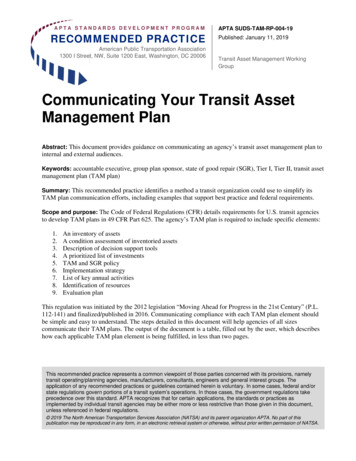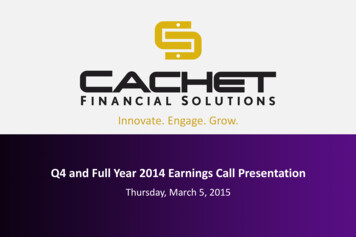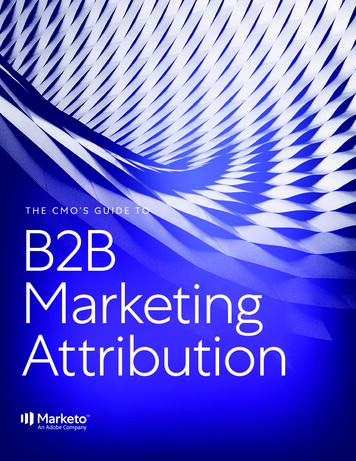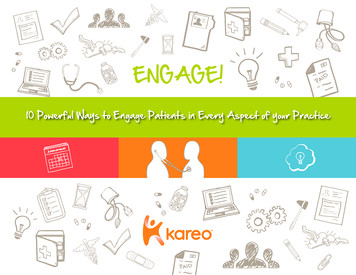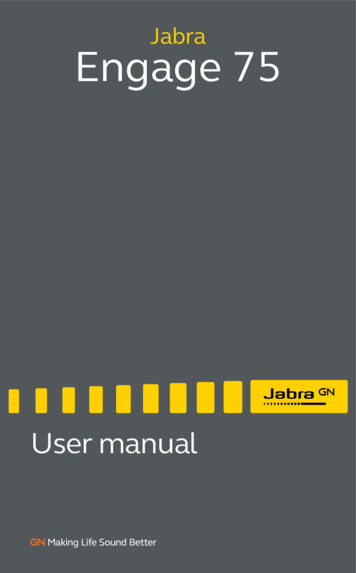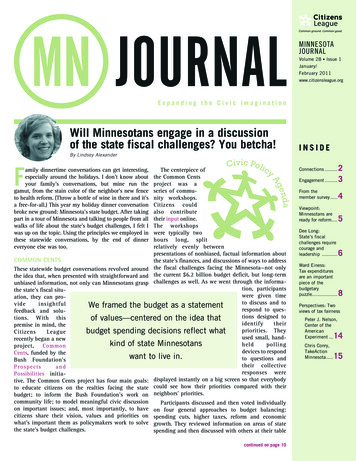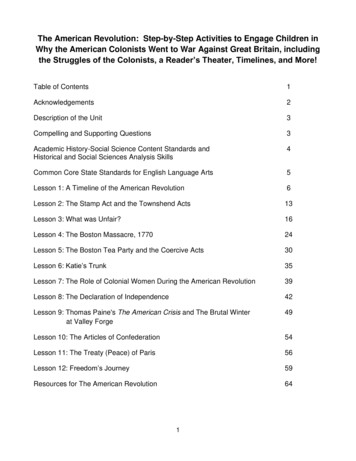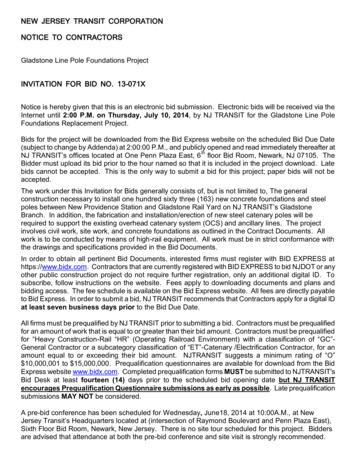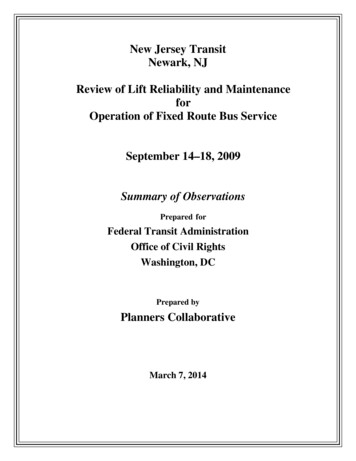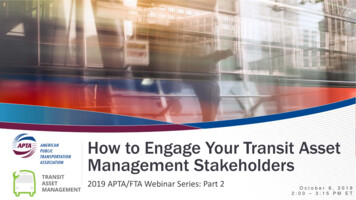
Transcription
How to Engage Your Transit AssetManagement Stakeholders2019 APTA/FTA Webinar Series: Part 2October 8, 20192:00 – 3:15 PM ET
American Public Transportation AssociationAPTA leads public transportation in a new mobility era, advocating to connect and buildthriving communities.1. APTA Leads As the voice for public transportation, proactively and assertively shaping andresponding to actions that impact public transportation2. Public Transportation Supporting the needs of public transportation agencies acting in the publicgood3. New Mobility Era Helping members anticipate, prepare for and understand the changes that areshaping our industry4. Advocating Fervently promoting the interests of the public transportation industry in all venues5. Thriving Communities Using transportation to enable individuals to access opportunities thatimprove their lives2
Transit Asset Management Activities1. Transit Performance Management Subcommittee Of the Planning, Policy, & Program Development Committee2. Standards and Recommended Practices State of Good Repair/Transit Asset Management Working Group3. APTA/FTA TAM Webinar Series4. Research and Reports Economic Cost of Failing to Modernize Public Transportation5. APTA Conferences and Sessions3
State of Good Repair/Transit AssetManagement Working GroupMission:To develop guidance for transit agencies as they implement asset managementprograms in compliance with FTA regulations and in alignment with industry bestpractice. This guidance, which may consist of white papers, training materials,presentations, and webinars, will complement the resources that have been publishedby the FTA with examples developed by industry peers.4
Guidance Published1. Communicating Your Transit Asset Management Plan2. Improving Asset Management Through Better Asset Information3. Building Internal Stakeholder Support for Your Asset Management Program4. Communication and Coordination with External Stakeholders for Transit AssetManagementAll are available on the APTA Standards website.5
Documents in Development1. Procuring Software to Support Transit Asset Management2. Using Asset Criticality to Make Investment Decisions3. How to Build an Asset Management TeamTarget publish date: Winter 20206
What’s Next?Theme of Documents: Continuous Improvement TAM Policy Creation and Implementation Identifying and Incorporation of Risk into TAMPs Incorporating Climate Vulnerability into TAMPs Best practices in using condition assessments and predicative maintenance intoimproved performance Best practices in linking TAMPs and Safety Plans7
APTA/FTA Webinar SeriesHeld on April 25, 2019: Communicating TAM Compliance and Programs Tools and resources for communicating the value of TAM agency executives and staff.Presentation slides and recording available on APTA website.October 8, 2019: Engaging Your TAM Stakeholders Communicating and involving both internal and external stakeholders in transit assetmanagement involves coordinated but different approaches.Planned, Late Fall 2019: Best Practices for Data Collection8
Stakeholder Engagement9
Stakeholder EngagementDesignConstructionMaintainOperateMany stakeholders are involved with each asset throughout the asset’s lifecycle.10
Stakeholder Engagement11
Today’s Moderator and Speakers Laura Zale, Manager of Asset Management, Southeastern PennsylvaniaTransportation Authority (SEPTA), Philadelphia, PA Victor Rivas, Strategic Consulting – Asset Management, Jacobs, Boston,MA Jordan Holt, Director of Performance, Washington Metropolitan AreaTransit Authority (WMATA), Washington, DC Todd Lang, Director of Transportation Planning, Baltimore MetropolitanCouncil, Baltimore, MD12
Asking QuestionsTo submit a question or comment to thepanel during the webinar, please type itinto the Question box on your screen andclick on the send arrow located at thebottom of the box.Be a Part of the Dialogue.13
PresenterVictor RivasStrategic Consulting – Asset ManagementJacobsBoston, MA14
Building Internal Stakeholder Support foran Asset Management ProgramRecommended practice document highlightingstrategies that a transit organization can use tobuild internal stakeholder support and buy-infor its asset management efforts15
Internal Stakeholders16
Internal Stakeholders Accountable Executive (Chief Executive Officer)Senior LeadershipOperations and Maintenance StaffAdministrative and Clerical StaffIt includes Contractors17
Why is Important to BuildInternal Stakeholder Supportfor Asset Management?18
Asset Management Guiding PrinciplesMaintain, update and enhance the agencies asset inventory tobetter invest in a state of good repair.Monitor and improve the condition of transits assets efficiency bysetting annual performance measures and targets, documenting theprogress towards those targets.Invest in state of good repair based on a structured decision frameworkto ensure available funds are spent where they are most needed.Maintain a list of investment priorities that consider safety, accessibilityand available funding.19
Asset Management Maturity Development20
Benefits of Transit Asset Management Optimized use of resources (human and financial) whilebeing able to deliver the best value to the customer Increased communication among departments withimproved collaborative behavior within the agency Improved public image through increased transparency andaccountability Enhanced opportunities for highlighting and replicating bestpractices21
Asset Management is an Agency-wide EffortAdvancing asset managementto a higher level of maturitycannot be achieved by asingle department oroperational unit, it requiresthe support and engagementof the entire munications,Marketing,Customer l,GovernmentRelations, RealEstateInformationTechnologySafety &SecurityTransit ementPlanning andProgramming22
Common Challenges23
Common Challenges Challenge 1 : Some employees do not understand the relevanceor impact of asset management in their daily activities. Strategy: Articulate/reiterate/model expectationsRaise awareness of the benefits of asset management to theagency and the departments, and how individual contributionsmake a difference.24
Common Challenges Challenge 2 : People are too busy to deal with additionalwork/initiatives. Staff feel that the responsibility lieselsewhere. Strategy: Create and build team cultureEmphasize the importance of achieving the agency’s goalsas a fully collaborative effort while establishing the internalstakeholders share of responsibility and accountability25
Common Challenges Challenge 3 : Staff show a lack of interest: “It’s not in my jobdescription.” Strategy: Develop personal buy-inEnsure that employees fully understand how their roles fitwithin the bigger picture. Self-motivation is key toperformance.26
Achieving and Sustaining AssetManagement Buy-in27
Achieving and Sustaining AssetManagement Buy-inCommunications and awareness-building Consider establishing asset management liaisons (TAMbassadors) EducationSample avenues for reaching out to internal stakeholders Printed and electronic media Regular briefings Targeted workshops28
Achieving and Sustaining AssetManagement Buy-inTop-down leadership and commitment Accountable Executive Asset Management Executive Team Department Heads29
Achieving and Sustaining AssetManagement Buy-inBottom-up buy-inSecuring strong endorsement from the topwill help further the asset managementagenda with front line employees30
Achieving and Sustaining AssetManagement Buy-inLeveraging improved asset informationAsset information is in constant state of renewal, thereforethe need to ensure continuous alignment of the followingcore business processes: Asset management vision and direction Life-cycle management Cross-asset planning and management31
Achieving and Sustaining AssetManagement Buy-inWorkforce developmentTo ensure asset management long-term viability the agencycould consider special workforce development strategiessuch as: recruitment of personnel capable of supporting assetmanagement functions asset management training succession planning32
Thank you.33
PresentersJordan HoltDirector of PerformanceWashington Metropolitan AreaTransit Authority (WMATA)Washington, DCTodd LangDirector of TransportationPlanningBaltimore Metropolitan CouncilBaltimore, MD34
Who, What, When, Where, Why and How?Communication and Coordinationwith External Stakeholdersfor Transit Asset ManagementRecommended practices for communicating with a range ofstakeholders about a transit agency’s transit asset management(TAM) program and plan.35
Who?36
Transit Asset Management Stakeholders37
Why?38
Benefits of Effective Communication andCoordinationWe agree theseinvestments areneeded and our top3 priorities are Shared understanding of needsIncreased credibilityImproved results39
Where and when?40
Means of Communicating Informal and formal Go beyond federal requirements Use multiple channels In personwebsitespresentationspostersvideos fact sheetsreports and planspress releasessocial media Omit sensitive information41
How?42
Communication Strategies Know what you want Know your audience’s interests Avoid the weeds Focus on big asset groupsCollapse condition data into two categories Be clear and succinct Use simple bar or line graphs Provide context and use pictures43
What?44
What is TAM? Set of tools and approachesto manage physicaltransportation assets moreefficiently Helps agencies bestmaintain their assets,balancing competing needsfor finite resources45
What is SOGR?If 60% of ourvehicles arebeyond theiruseful life, doesthat mean they areunsafe? “State of Good Repair” meansthat assets are in fair or bettercondition and/or are not beyondtheir useful life SOGR Safety Costs less in long-run and resultsin better service for customers46
What is our backlog? Backlog cost ofachieving a state ofgood repair and thenmaintaining it overtime47
What happens if we don’t invest in SOGR?Impact on customersImpact on backlog48
How do we compare to others?Why didn’t we meet ourtargets last year?What are we doing tolower our targets in thefuture?How much will it cost toreduce the target tomatch Agency X’starget?Agency X is about thesame age as us and/orhas the same number ofvehicles. Why are theirtargets and assetcondition so much“better” than ours?How is it OK to have aperformance target that60% of our vehicles arebeyond their useful life?49
Thank you.50
Q&A with Today’s Moderator andSpeakers Laura Zale, Manager of Asset Management, Southeastern PennsylvaniaTransportation Authority (SEPTA), Philadelphia, PA Victor Rivas, Strategic Consulting – Asset Management, Jacobs, Boston,MA Jordan Holt, Director of Performance, Washington Metropolitan AreaTransit Authority (WMATA), Washington, DC Todd Lang, Director of Transportation Planning, Baltimore MetropolitanCouncil, Baltimore, MD51
Asking Audience QuestionsTo submit a question or comment to themoderator during the session or duringthe Q&A, please type it into the Questionbox on your screen and click on the sendarrow located at the bottom of the box.Be a Part of the Dialogue.52
Q&A with Today’s Moderator andSpeakers Laura Zale, Manager of Asset Management, Southeastern PennsylvaniaTransportation Authority (SEPTA), Philadelphia, PA Victor Rivas, Strategic Consulting – Asset Management, Jacobs, Boston,MA Jordan Holt, Director of Performance, Washington Metropolitan AreaTransit Authority (WMATA), Washington, DC Todd Lang, Director of Transportation Planning, Baltimore MetropolitanCouncil, Baltimore, MD53
How to Engage Your Transit AssetManagement Stakeholders2019 APTA/FTA Webinar Series: Part 2October 8, 2019
Tools and resources for communicating the value of TAM agency executives and staff. Presentation slides and recording available on APTA website. October 8, 2019: Engaging Your TAM Stakeholders Communicating and involving both internal and external stakeholders in transit asset
